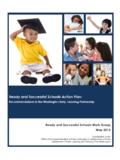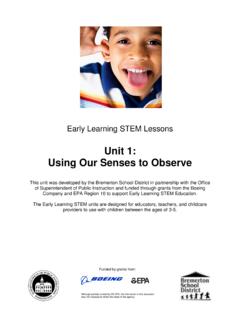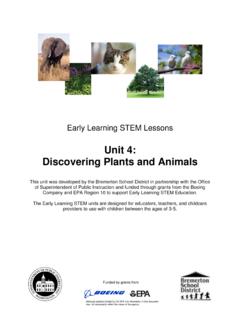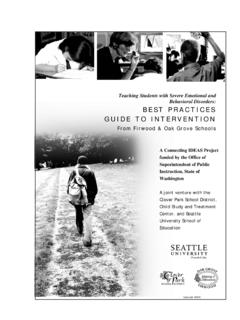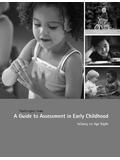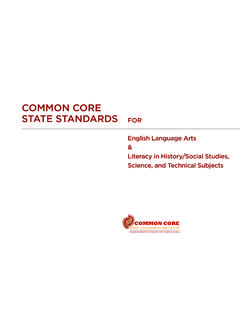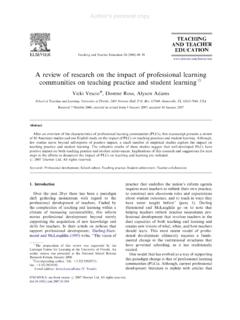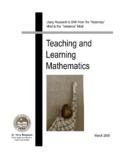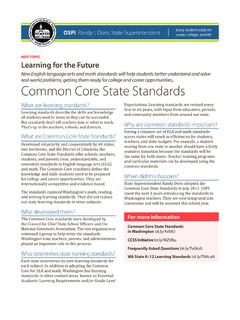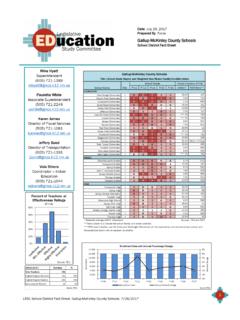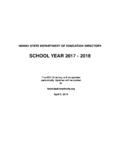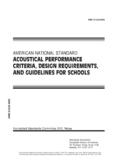Transcription of Nine Characteristics of High Performing Schools
1 nine Characteristics of high Performing Schools Second Edition Resource List Becoming a high - Performing school takes many years of hard work. There is no silver bullet--no single thing a school can do to ensure high student performance. Research has found that high - Performing Schools have a number of common Characteristics . A school may be doing well in some areas but need help in others. The second edition of the nine Characteristics of high - Performing Schools maintains the original Characteristics and definitions. It adds information from about 120 new research and professional references, as well as relevant OSPI documents, to help educators deepen their understanding of the Characteristics , and it provides additional strategies for expanding implementation. This resource list provides the names of key websites, books, reports, and articles that can be used to help Schools improve in each of the Characteristics of high - Performing Schools .
2 Information about various Characteristics is often embedded throughout these resources. After assessing the areas that need the most attention, review and then discuss the materials mentioned in this resource list in order to focus your school improvement efforts. Good luck! G. Sue Shannon, Ed. D. Senior Researcher Assessment and Student Information Office of Superintendent of Public Instruction Contents Introduction Starting Points Characteristics 1. A Clear and Shared Focus 2. high Standards and Expectations for All Students 3. Effective school Leadership 4. high Levels of Collaboration and Communication 5. Curriculum, Instruction, and Assessments Aligned with State Standards 6. Frequent Monitoring of Learning and Teaching 7. Focused Professional Development 8. Supportive Learning Environment 9. high Levels of Family and Community Involvement Appendix A: Bibliography and analysis matrix National Research Reports Washington State Research Reports nine Characteristics Resource List Page 2 Introduction The second edition expands and deepens the discussion of the nine Characteristics .
3 The introduction provides an overview of several concepts: Effective processes for improving Schools Expanded perspectives on effective leadership Relational trust ( , trusting relationships among person in an organization). Quality instruction, grading practices, and monitoring Professional learning communities Cultural competence and culturally responsive teaching Family and community engagement in Schools high school improvement District improvement Need-based allocation of resources (funding, staffing, and support). nine Characteristics Resource List Page 3 References Banks, J., Cochran-Smith, M., Moll, L., Richert, A., Zeichner, K., LePage, P., Darling-Hammond, L., Duffy, H., with McDonald, M. (2005). Teaching Diverse Learners. In Darling-Hammond, L., Bransford, J., LePage, P., Hammerness, K., & Duffy, H. (Eds.). Preparing Teachers for A. Changing World: What Teachers Should Learn and Be Able to Do.
4 San Francisco: John Wiley &. Sons, Inc. Blankstein, (2004). Failure is NOT an Option: Six Principles that Guide Student Achievement in high - Performing Schools . Thousand Oaks, Ca: Corwin Press and HOPE Foundation. Bryk. & Schneider, B. (2002). Trust in Schools : A Core Resource for Improvement. New York: Russell Sage Foundation. Carey, K. (2004). The Real Value of Teachers: Using New Information about Teacher Effectiveness to Close the Achievement Gap. Thinking K-16. Washington DC: The Education Trust. Darling-Hammond, L. (2000). Teacher Quality and Student Achievement: A Review of State Policy Evidence. Education Policy Analysis Archives. 8(1). Darling-Hammond, L., Bransford, J., with LePage, P., Hammerness, K., & Duffy, H. (Eds.). (2005). Preparing Teachers for a Changing World: What Teachers Should Learn and Be Able to Do. Sponsored by the National Academy of Education.
5 San Francisco: Jossey-Bass. Demmert, Jr. (2001). Improving Academic Performance among Native American Students: A. Review of the Research Literature. Charleston, WV: ERIC. Clearinghouse on Rural Education and Small Schools . Appalachian Educational Laboratory. DuFour, R., Eaker, R., & DuFour, R. (Eds.). (2005). On Common Ground: The Power of Professional Learning Communities. Bloomington, IN: National Educational Service. Edmonds, R. (1979). Effective Schools for the Urban Poor. Educational Leadership. 37. Education Trust. (2006). Funding Gaps 2006. Washington DC: The Education Trust. Elmore, (2000). Building a New Structure for school Leadership. Washington, DC: The Albert Shanker Institute. Fullan, M. (2005). Leadership & Sustainability: System Thinkers in Action. Thousand Oaks, CA: Corwin Press. Fullan, M. (2006). Turnaround Leadership. Thousand Oaks, CA: Corwin Press.
6 Gay, G. (2000). Culturally Responsive Teaching: Theory, Research, and Practice. New York: Teachers College Press. George, , McEwin, , & Jenkins, (2000). The Exemplary high school . New York: Harcourt College Publishers. Goode, T., Jones, W., & Mason, J. (2002). A Guide to Planning and Implementing Cultural Competence Organization Self-assessment. Washington, : National Center for Cultural Competence. Georgetown University. Child Development Center. nine Characteristics Resource List Page 4 Goodlad, (1984). A Place Called school : Prospects for the Future. New York: McGraw-Hill Book Company. Hargreaves, A. & Fink, D. (2006). Sustainable Leadership. San Francisco, CA: Jossey-Bass. Henchey, N. with Dunnigan, M., Gardner, A., Lessard, C., Muhtadi, N., Raham, H., & Violato, C. (2001). Schools that Make a Difference. Final Report: Twelve Canadian Secondary Schools in Low-Income Settings.
7 Kelowna, : Society for the Advancement of Excellence in Education. King, , Sims, A., & Osher, D. (nd). How is Cultural Competence Integrated in Education. #def. Retrieved 12/1/2006. Langer, (2004). Getting to Excellent: How to Create Better Schools . New York: Teachers College Press. Lezotte, (1991). Correlates of Effective Schools : The First and Second Generation. Effective Schools Products, Ltd., Okemos, MI. Little, (1990). The Persistence of Privacy: Autonomy and Initiative in Teachers' Professional Relations. Teachers College Record. 91(4). Lobdell, G. (2007, Feb. 8). Personal communication. Center for Educational Effectiveness. Lockwood, & Secada, (1999). The Hispanic Dropout Problem and Recommendations for Its Solution. In Transforming Education for Hispanic Youth: Exemplary Practices, Programs, and Schools . NCBE Resource Collection Series, No. 12. Marzano, (2003).
8 What Works in Schools : Translating Research into Action. Alexandria, VA: ASCD. Marzano, , Waters, T., & McNulty, (2005). school Leadership that Works. From Research to Results. Alexandria, VA: ASCD. Aurora, CO: McREL. McKinley, J. (2005). Effective Teaching Strategies for high Performing African American Students in an Urban District. Paper presented at American Educational Research Association Annual Meeting in Montreal. McLaughlin, & Talbert, (2006). Building school -Based Teacher Learning Communities: Professional Strategies to Improve Student Achievement. New York: Teachers College Press. Northwest Regional Educational Laboratory. (2005). Research You Can Use to Improve Results. Office of Superintendent of Public Instruction. ___ Grade Level Expectations; On-Line Grade Level Resources. Olympia, WA. ___ (2007). Washington State Guidance for Selection of Instructional Materials to Meet District and State Standards.
9 Olympia, WA. ___ (2005). Washington State Professional Development Planning Guide IN ACTION: Linking Professional Development to Improved Student Learning. Olympia, WA. ___ (2004). Washington State K-12 Reading Model: Implementation Guide. Olympia, WA. ___ (2006). Using Response to Intervention (RTI) for Washington's Students. Olympia, WA. nine Characteristics Resource List Page 5 ___ (2007). Washington State Transitional Bilingual Instructional Program Guidelines. ___ (2005). Washington State English Language Development Instructional Materials Review ___ Washington State English Language Development (ELD) Content Standards ___ (2005) school Improvement Process Guide. Olympia, WA. ___ (2005). school System Improvement Resource Guide. with Washington Association of school Administrators. Olympia, WA. Peske, & Haycock, K. (2006). Teaching Inequality: How Poor and Minority Students Are Shortchanged on Teacher Quality.
10 Washington DC: The Education Trust. Reeves, D. (2007). Closing the Implementation Gap. Educational Leadership. 64(6). Rice, (2003). Teacher Quality: Understanding the Effectiveness of Teacher Attributes. Washington, DC: Economic Policy Institute. Roza, M. (2006). How Districts Shortchange Low-income and Minority Students. Funding Gaps 2006. Washington, DC: The Education Trust. Roza, M., Guin, K., & Davis, T. (2007). What is the Sum of the Parts: How Federal, State, and District Funding Streams Confound Efforts to Address Different Student Types. school Finance Redesign Project. Center on Reinventing Public Education. Seattle, WA: University of Washington. Shannon, & Bylsma, P. (2002). Addressing the Achievement Gap: A Challenge for Washington Educators. Olympia, WA: OSPI. Shannon, & Bylsma, P. (2004). Characteristics of Improved school Districts: Themes from Research.
